AUDI A8 2018 Owners Manual
Manufacturer: AUDI, Model Year: 2018, Model line: A8, Model: AUDI A8 2018Pages: 356, PDF Size: 54.71 MB
Page 221 of 356
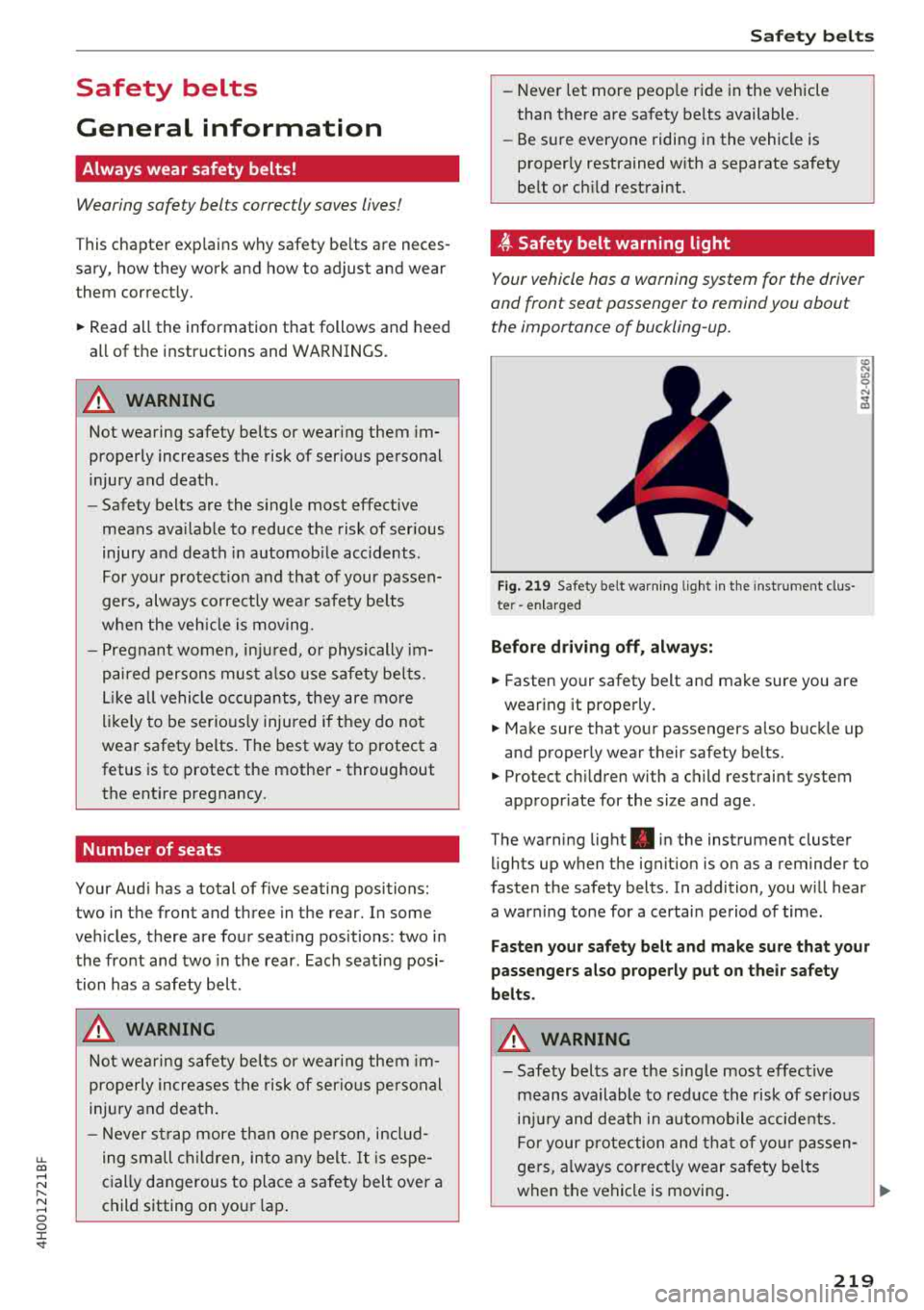
u. co .... N
" N .... 0 0 :c '
General information
Always wear safety belts!
Wearing safety belts correctly saves lives!
This chapter explains why safety be lts are neces
sary, how they work and how to adjust and wear
them correctly.
~ Read all the information that follows and heed
all of the instructions and WARNINGS.
A WARNING
Not wearing safety belts or wearing them im
properly increases the risk of serious personal
injury and death.
- Safety belts are the s ingle most effective
means ava ilable to reduce the risk of serious
injury and death in automobi le accidents.
For your protection and that of your passen
gers, always co rrect ly wea r safety be lts
w hen the veh icle is mov ing.
- Pregnant wome n, in ju red, o r physically im
paired persons mus t also use safety be lts.
Lik e al l vehicle oc cupan ts, they are mo re
li kely to be serio usly injured i f th ey do no t
wear safety be lts . The best way to protect a
fetus is to protect the mothe r -throug hout
the ent ire pregnancy.
Number of seats
Your Aud i has a total of five seating positions:
two in the front and three in t he rear. In some
veh icles, there are four seat ing positions: two in
the fro nt and two in the rear . Each seati ng posi
tion has a safety belt.
A WARNING
N ot we aring safety bel ts or wear ing them im
pro perly in cre ases the risk of ser io us pe rsonal
inju ry and dea th.
- Never st rap more th an one pe rso n, includ
ing sm all c hildr en, in to any be lt.
It is espe
c ially dangerous to place a safety belt over a
child sitting on your lap .
Safet y be lts
- Never let more peop le r ide in the vehicle
than there are safety be lts available.
- Be s ure everyone riding in the vehicle is
proper ly restrained w ith a separate safety
be lt or ch ild restraint.
,ff. Safety belt warning light
Your vehicle has a warning system for the driver
and front seat passenger to remind you about
the importance of buckling-up.
F ig. 21 9 Safety belt warnin g lig ht in t he inst rument clus·
te r -en larged
Befor e dr ivi ng off , always :
~ Fasten your safety belt and make sure you are
wearing it properly.
~
~ Make sure that your passengers a lso buckle up
and properly wear their safety belts.
~ Protect ch ildren with a c hild restraint system
appropr iate for the size and age .
The warning lig ht . in the instrument cluster
lights up when the ignit ion is on as a reminder to
fasten the safety belts . In addition, you will hear
a war ning tone for a certai n period of time .
Fasten your safet y belt and make su re that your
passengers also properly put on their safety
b e lts .
A WARNING
-
-Safety bel ts are the sing le m ost effec tive
means available to red uce the risk of ser io u s
i njur y and death in a utomob ile accidents.
F or your p rotection and that of yo ur passen
ge rs, always correc tly wear safety bel ts
when the vehicle is moving .
~
219
Page 222 of 356
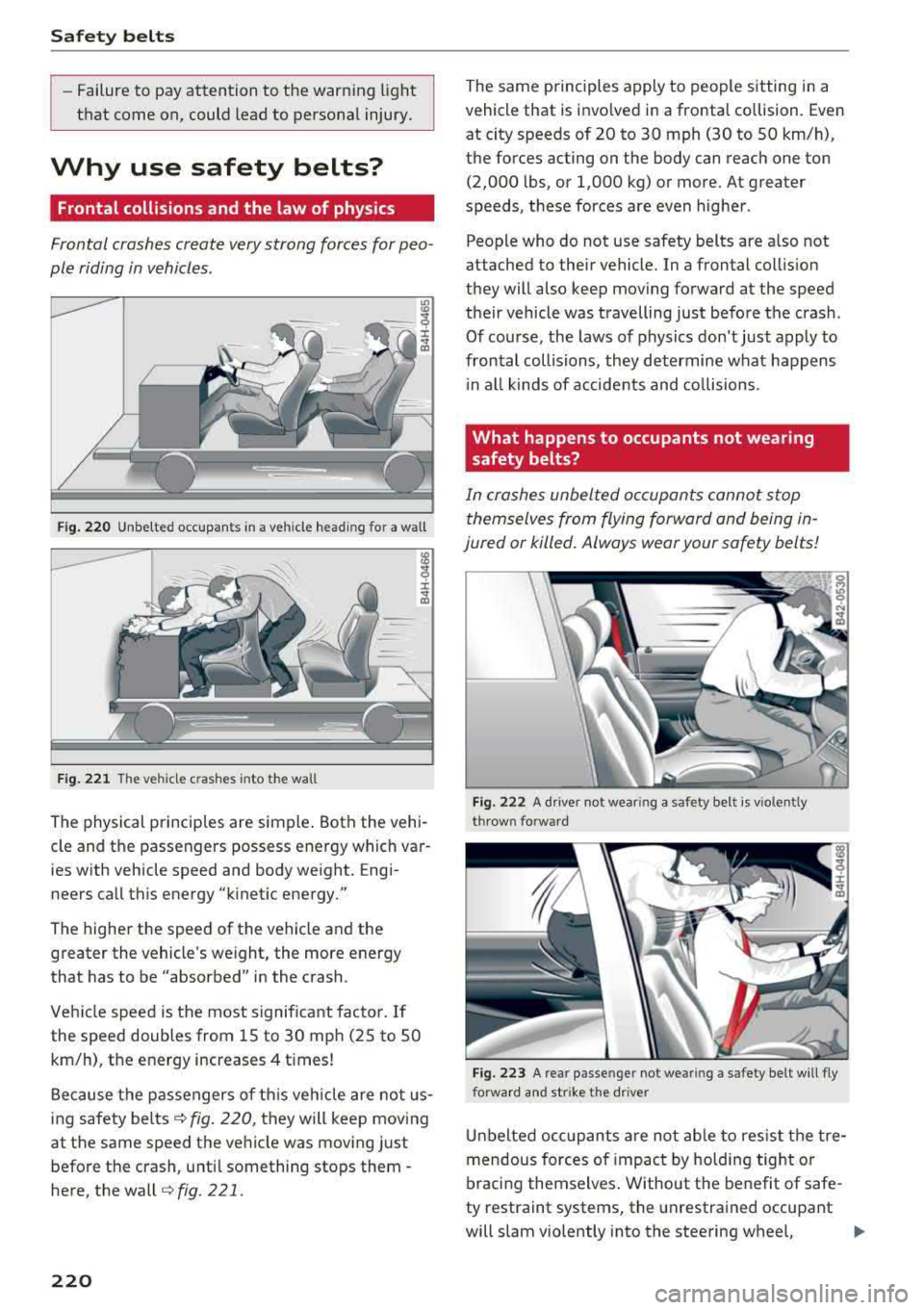
Safe ty belts
-Failure to pay attention to the warning light
that come on, could lead to personal injury.
Why use safety belts?
Frontal collisions and the law of physics
Frontal crashes create very strong forces for peo
ple riding in vehicles.
F ig. 220 Unbe lted occupants in a vehicle heading for a wall
Fig . 221 The veh icle crashes into the wall
The physical principles are simple . Both the vehi
cle and the passengers possess energy which var
ies with vehicle speed and body weight. Engi
neers call this energy "kinet ic energy."
The higher the speed of the vehicle and the greater the vehicle 's we ight, the more energy
that has to be "absorbed" in the crash.
Vehicle speed is the most significant fac tor. If
the speed doubles from 15 to 30 mph (25 to SO
km/h), the energy increases 4 times!
Because the passengers of th is veh icle are not us
ing safety
belts<=> fig. 220, they will keep mov ing
at the same speed the ve hicle was moving just
before the crash, u nti l something stops them -
here, the wall<=>
fig. 221.
220
The same principles apply to people s itting in a
vehicle that is involved in a fronta l collision. Even
at city speeds of 20 to 30 mph (30 to 50 km/h),
the forces acting on the body can reach one ton
(2,000 lbs, or 1,000 kg) or more. At greater
speeds, these forces are even higher.
People who do not use safety belts are a lso not
attached to their vehicle. In a frontal coll is ion
they will also keep mov ing forward at the speed
their vehicle was travelling just befo re the crash.
Of course, the laws of physics don't just apply to
frontal collisions, they determine what happens
i n a ll kinds of accide nts and co lli sions.
What happens to occupants not wearing
safety belts?
In crashes unbelted occupants cannot stop
themselves from flying forward and being in
jured or killed. Always wear your safety belts!
Fig. 222 A driver not wearing a safety belt is violently
thrown forward
F ig. 223 A rear passenger not wearing a safety belt will fly
forwa rd a nd strike the driver
Unbelted occ upants are not ab le to res ist the tre
mendous forces of impact by holding tight or
braci ng themselves . Without the benefit of safe
ty restraint systems, the unrestra ined occupant
will slam violently into the steering wheel,
liJJ,,
Page 223 of 356
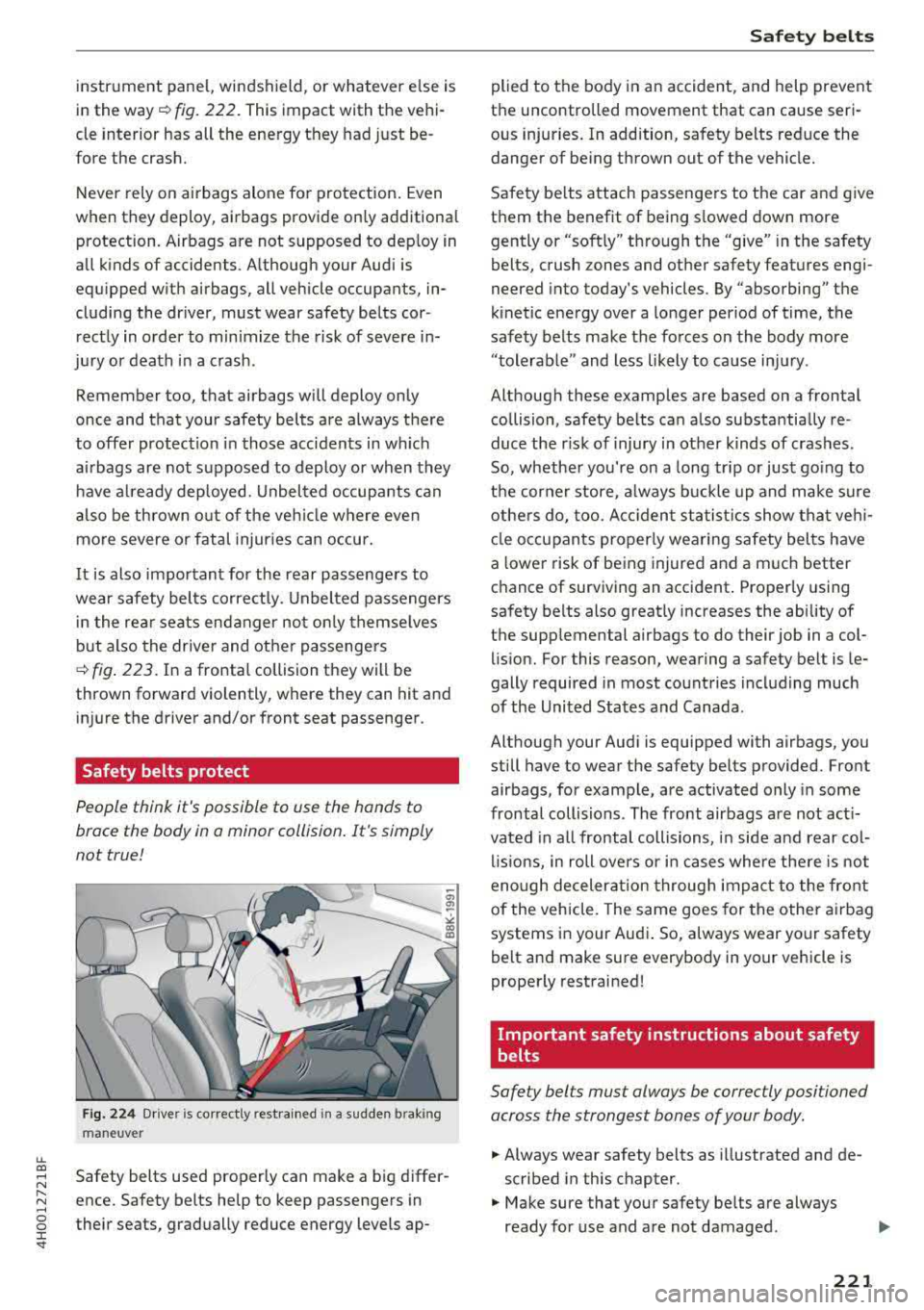
lL t:0 ....
"" ......
"" .... 0 0 :c '
in the way ¢
fig. 222. This impact w ith the vehi
cle interior has all the energy they had just be
fore the crash.
Never rely on airbags alone fo r protection . Even
when they deploy, airbags provide on ly additiona l
protection. Airbags are not supposed to dep loy in
all kinds of accidents. A lthough your Audi is
equ ipped w ith airbags, all vehicle occupants, in
cluding the dr iver , must wear safety belts cor
rectly in order to minimize the risk of severe in
jury or death in a crash .
Remember too, tha t airbags will deploy only
once and that your safety belts are always there
to offer protec tion in those acc idents in w hich
airbags are not supposed to deploy or when they
have a lready deployed. Unbel ted occupants can
also be thrown o ut of the vehi cle where even
more severe or fatal injur ies can occur .
It is also important for the rear passenge rs to
wear s afety bel ts corre ctly . U nbel ted passengers
in the re ar seats endanger no t onl y themse lves
but also the driver and ot her passengers
¢ fig . 223. In a fronta l collision they will be
thrown forward violently, where they can hit and
in jure the driver and/or front seat passenger .
Safety belts protect
People think it's possible to use the hands to
brac e the body in a minor collision . It 's simply
not true!
F ig . 2 24 Drive r is correctly rest ra ined in a sudde n brak ing
m aneuver
Safety belts used properly can make a big d iffer
ence. Safety belts he lp to keep passengers in
their seats, gradually reduce energy leve ls ap-
Safet y bel ts
plied to the bo dy i n an accident, and help prevent
t h e uncontrolled movement that can cause seri
ous injuries. In addition, safety belts reduce the
danger of be ing th rown out of the vehicle.
Safety be lts attach passengers to the car and g ive
them the benefit of be ing s lowed down more
gently or "soft ly" th rough the "give" in the safety
belts, crush zones and other safety features engi
neered into today's vehicles. By "absorbing" the
k inetic ene rgy over a longer period of t ime, the
sa fe ty belts make the fo rces on the body more
"tolerab le " and less likely to ca use in jury.
Although these examples are based on a frontal collision, safety be lts can also substa ntia lly re
duce the r is k of injury in ot her k inds of crashes .
So, whethe r you're on a long tr ip or just go ing to
t h e cor ner store , a lways b uck le up and make sure
othe rs do, too. A cciden t st atis tic s show tha t ve hi
cl e occupan ts properly wea ring safety bel ts have
a lower risk of be ing injured and a muc h better
chance of surviving an acci dent . Properly using
sa fety belts also great ly increases the ability of
the supp lemental airbags to do their job in a col
lis ion. For this reason, wearing a safety belt is le
gally required in most count ries includ ing much
of the United States and Canada .
Although your Aud i is equipped with airb ags, you
still have to wear the safety belts provided. Front airbags, for example, are activated only in some
frontal collisions. The front airbags a re not ac ti
vated in a ll frontal collisions , in side and rear co l
li sio ns, in roll overs or i n cases where the re is not
eno ugh deceleration throug h impact to the front
of the veh icle. The same goes for the other a irbag
systems in your Audi . So, always wear your safety
belt and make sure everybody in your vehicle is
properly rest rained !
Important safety instructions about safety
belts
Safe ty belts must always be correctly posi tioned
across the strongest bones of your body.
.. Always wear safety belts as illustrated and de
scribed in this chapter .
.. Make sure that your safety be lts are always
ready for use and are not damaged.
221
Page 224 of 356
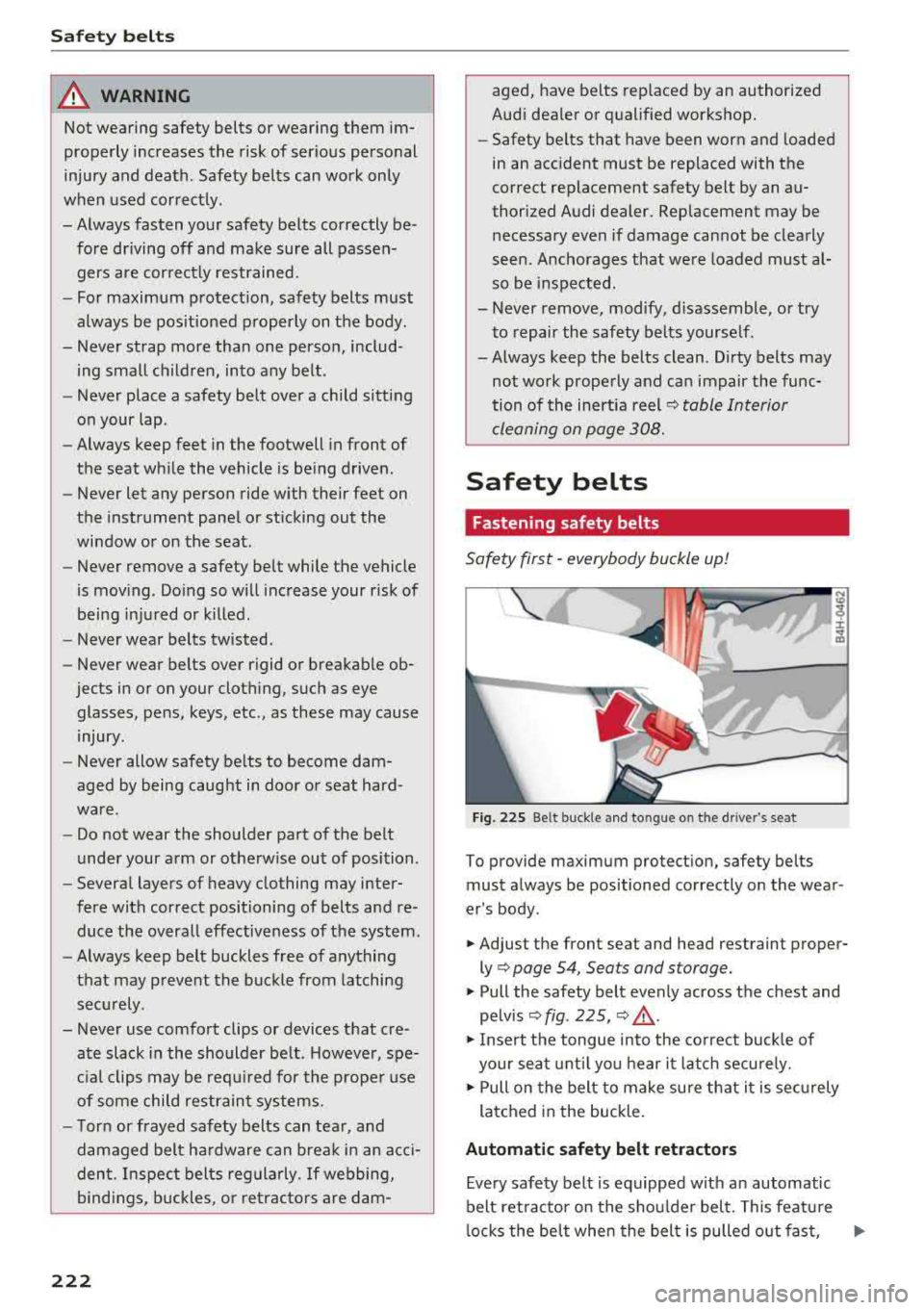
Safety belts
A WARNING
Not wearing safety belts or wearing them im
properly increases the risk of serious personal
injury and death . Safety belts can work only
when used correctly .
-Always fasten your safety belts correctly be fore driving off and make sure all passen
gers are correctly restrained.
-For maximum protection, safety belts must
always be positioned properly on the body.
-Never strap more than one person, includ
ing small children, into any belt .
-Never place a safety belt over a child sitting
on your lap.
- Always keep feet in the footwell in front of
the seat while the vehicle is being driven .
-Never let any person ride with their feet on
the instrument panel or sticking out the
window or on the seat.
-Never remove a safety belt while the vehicle
is moving . Doing so will increase your risk of
being injured or killed .
- Never wear belts twisted.
-Never wear belts over rigid or breakable ob-
jects in or on your clothing, such as eye
glasses, pens, keys, etc ., as these may cause
injury .
-Never allow safety belts to become dam
aged by being caught in door or seat hard
ware .
-Do not wear the shoulder part of the belt
under your arm or otherwise out of position.
-Several layers of heavy clothing may inter
fere with correct positioning of belts and re duce the overall effectiveness of the system.
-Always keep belt buckles free of anything
that may prevent the buckle from latching
securely .
-Never use comfort clips or devices that cre
ate slack in the shoulder belt. However, spe
cial clips may be required for the proper use
of some child restraint systems.
-Torn or frayed safety belts can tear, and
damaged belt hardware can break in an acci
dent . Inspect belts regularly .
If webbing,
bindings, buckles, or retractors are dam-
222
aged, have belts replaced by an authorized
Audi dealer or qualified workshop.
-Safety belts that have been worn and loaded
in an accident must be replaced with the
correct replacement safety belt by an au
thorized Audi dealer. Replacement may be
necessary
even if damage cannot be clearly
seen . Anchorages that were loaded must al
so be inspected.
-Never remove, modify , d isassemble, or try
to repair the safety belts yourself .
-Always keep the belts clean. Dirty belts may not work properly and can impair the func
tion of the inertia
reel¢ table Interior
cleaning on page 308.
Safety belts
Fastening safety belts
Safety first -everybody buckle up!
Fig. 225 Be lt buckle and tongue on the drive r's seat
To provide maximum protection, safety belts
must always be positioned correctly on the wear
er's body .
.. Adjust the front seat and head restraint proper
ly¢ page 54, Seats and storage.
.. Pull the safety belt evenly across the chest and
pelvis
Q fig . 225, Q _&. .
.. Insert the tongue into the correct buckle of
your seat until you hear it latch securely.
.. Pull on the belt to make sure that it is securely
latched in the buckle.
Automatic safety belt retractors
Every safety belt is equipped with an automatic
belt retractor on the shoulder belt. This feature
locks the belt when the belt is pulled out fast,
..,.
Page 225 of 356
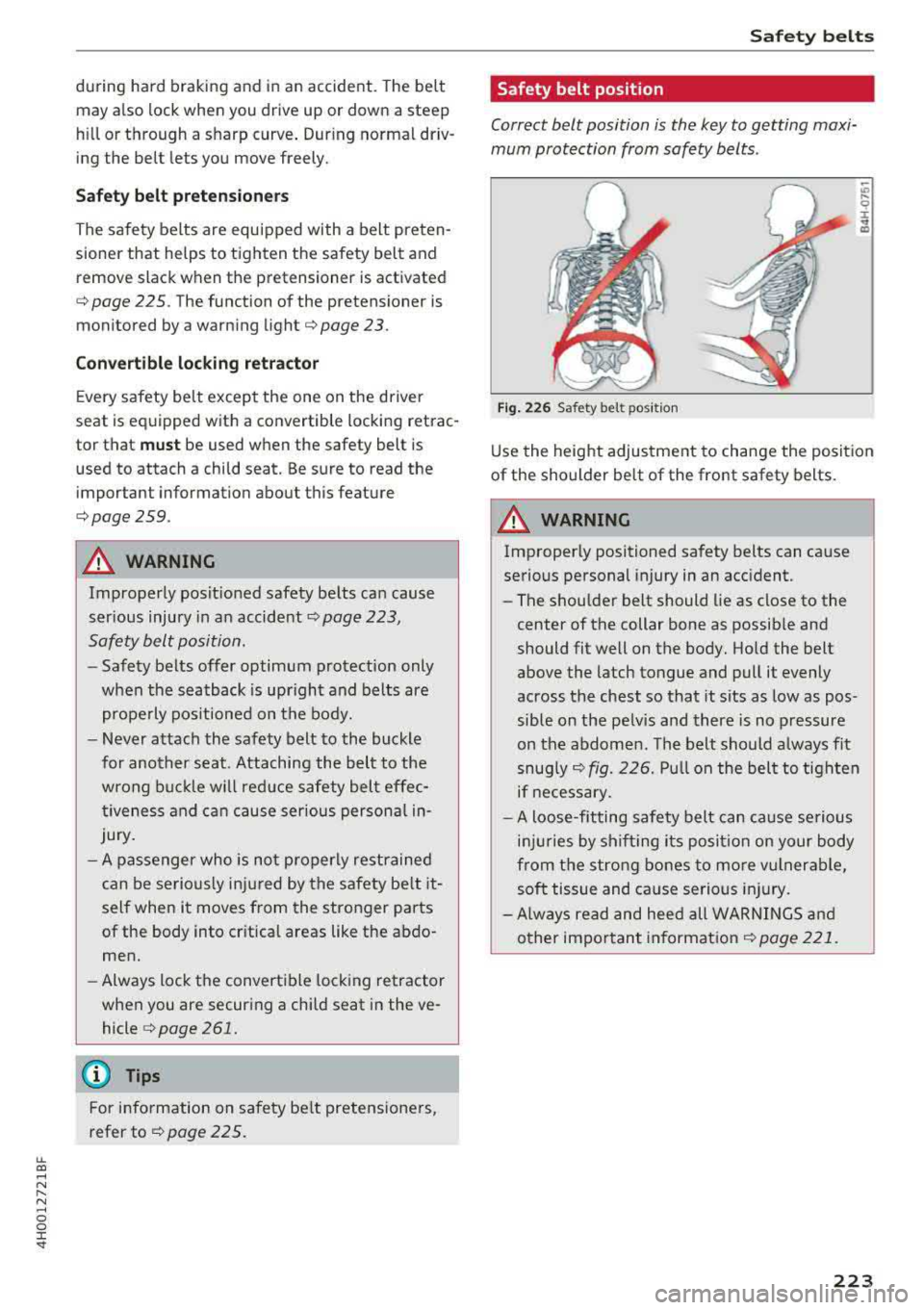
lL t:0 ....
"' ......
"' .... 0 0 :c '
may a lso lock when you drive up or down a ste ep
h ill or through a sharp curve . Dur ing normal driv
ing the belt lets you move freely .
Safety belt pretension ers
The safety belts are equipped with a belt pre ten
sioner that helps to tighten the safety belt and remove slack when the pretens ioner is activated
c:> page 225. The function of the p retensioner is
monitored by a warn ing light
c:> page 23.
Conv ert ible loc king retractor
Every safety belt except the one on the driver
seat is equipped with a convertible locking retrac
tor that
must be used when the safety belt is
used to attach a child seat. Be sure to read the important information about this feature
c:> page 259 .
A WARNING
Improperly posit ioned safety belts ca n cause
ser ious injury in an accident
c:> page 223 ,
Safety belt position.
- Safety belts offer optimum protection only
when the seatback is upright and belts are
prope rly pos itioned on the body.
- Never attach the safety belt to the buckle
for another seat . Attaching the belt to the
wrong bu ckle w ill reduce safety belt effec
t iveness and can cause serious persona l in
jury .
- A passenger who is not p roperly restrained
can be seriously injured by the safety be lt it
sel f when it moves from the stronger parts
of the body into critical areas like the abdo
men.
- Always lock the convert ible lock ing retractor
when you are secur ing a child seat in the ve
hicle
c> page 261.
@ Tips
For information on safety be lt pretensione rs,
refer to
c:> page 225.
Safet y bel ts
Safety belt position
Correct belt position is the key to getting maxi
mum protection from safety belts .
Fig . 2 26 Safet y be lt po sit ion
U se the height adjustment to change the position
of the shoulder belt of the front safety belts.
.&_ WARNING ~
Improperly positioned safety belts can ca use
serious personal injury in an acc ident.
- The shou lder belt should l ie as close to the
center of the collar bone as possib le and
should fit well on the body. Ho ld the belt
above the latch tongue and pull it evenly
across the chest so that it sits as low as pos
sible on the pelvis and there is no pressure
on the abdomen. The belt should a lways fit
snug ly
c:> fig. 226. Pu ll on the bel t to tighten
if necessary.
- A loose-fit ting safety belt can cause serious
in jur ies by shi fting its position on your body
from the strong bones to mo re v ulnerable,
soft tissue and cause se rious in jury.
- Always read and heed all WARN INGS and
o ther impor tant informat ion
c:> page 221.
223
Page 226 of 356
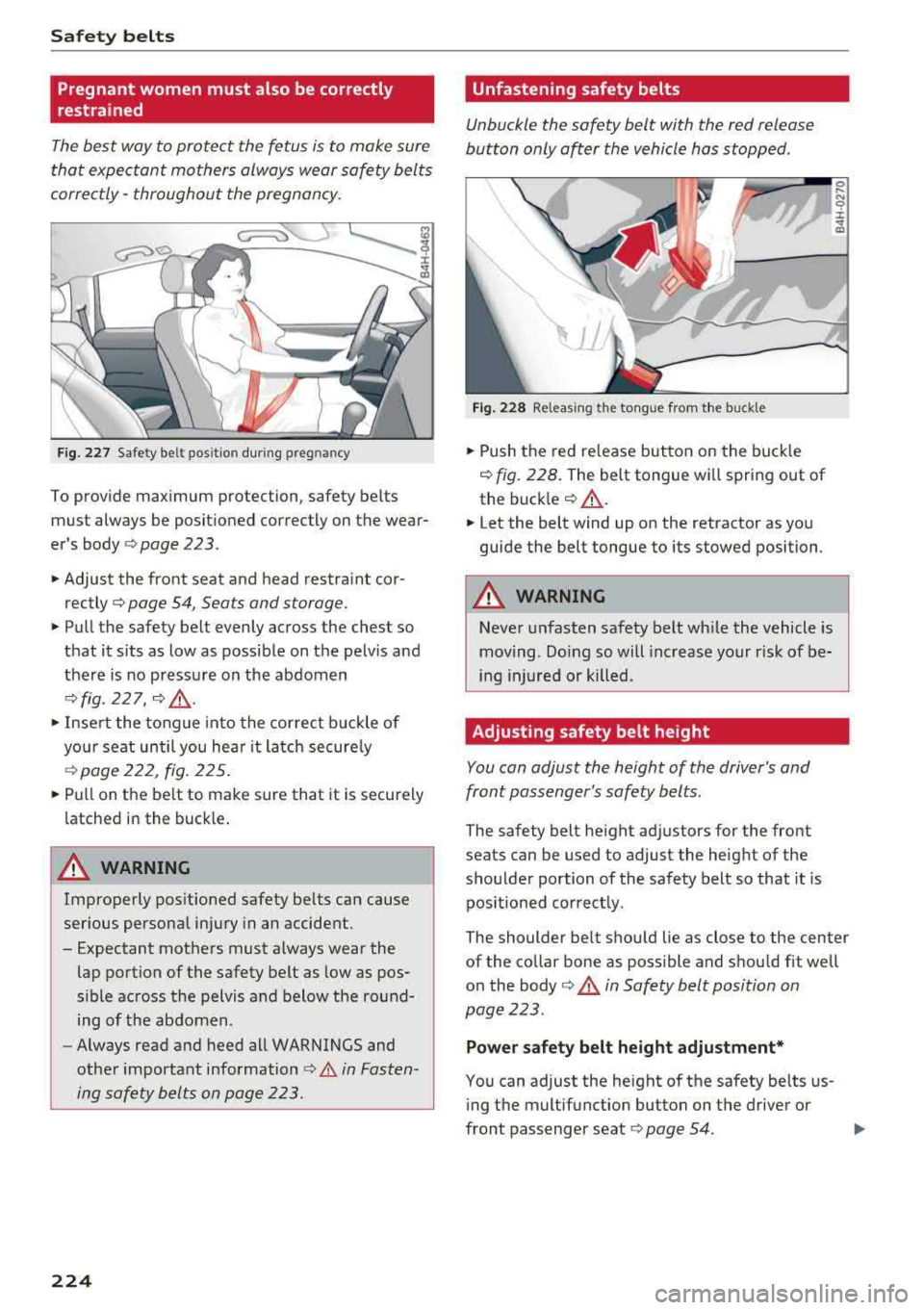
Safe ty belts
Pregnant women must also be correctly
restrained
The best way to protect the fetus is to make sure
that expectant mothers always wear safety belts
corre ctly
-throughout the pregnancy.
F ig. 227 Safety belt pos ition during pregnancy
To prov ide max imum protection, safety belts
must always be posit ioned correctly on the wear
er's body
¢ page 223 .
~ Adjust the front seat and head restraint cor
rectly¢ page 54, Seats and storage.
~ Pull the safety belt evenly across the chest so
that it sits as low as possible on the pelv is and
there is no press ure on the abdomen
¢fig. 227, ~ .&_ .
~ Inse rt the tongue into the cor rect buckle of
yo ur seat until you hea r it latch secure ly
¢ page 222, fig. 225 .
~ Pull on the be lt to make sure that it is securely
l atched in the buck le .
A WARNING
Improperly pos it ioned safety belts can cause
ser ious persona l injury in an accident.
- Expectant mothers must a lways wear the
lap portion of the safety belt as low as pos
sible across the pelvis and below the round ing of the abdomen.
- Always read and heed all WARNINGS and
other important
information ¢.&. in Fasten
ing safety belts on page 223.
224
Unfastening safety belts
Unbuckle the safety belt with the red release
button only ofter the vehicle hos stopped.
.,,
Fig . 22 8 Releasing the tongue from the buckle
~ Push the red re lease but ton on the buck le
¢
fig. 228. The belt tongue w ill spring out of
the buck le
¢ ,A .
~ Let the belt wind up on the retractor as yo u
guide the belt tongue to its stowed position.
A WARNING
Never unfasten safety be lt wh ile the vehicle is
moving . Do ing so will increase your r isk of be
ing inj ured or killed.
Adjusting safety belt height
You con adjust the height of the driver's and
front passenger's safety belts.
The safety belt he ight ad justers for the front
seats can be used to adjust the height of the
sho ulder portion of the safety belt so that it is
pos it ione d correct ly.
0 ,._ N 0 :i:
"' m
The shoulder be lt shou ld lie as close to the center
of the collar bone as poss ible and shou ld fit well
o n the body
¢ .&. in Safety belt position on
page 223 .
Power safety belt he ight adjustment*
You can adjust the he ight of the safety be lts us
ing the multif unction button on the driver or
front passenger seat
¢ page 54 .
Page 227 of 356
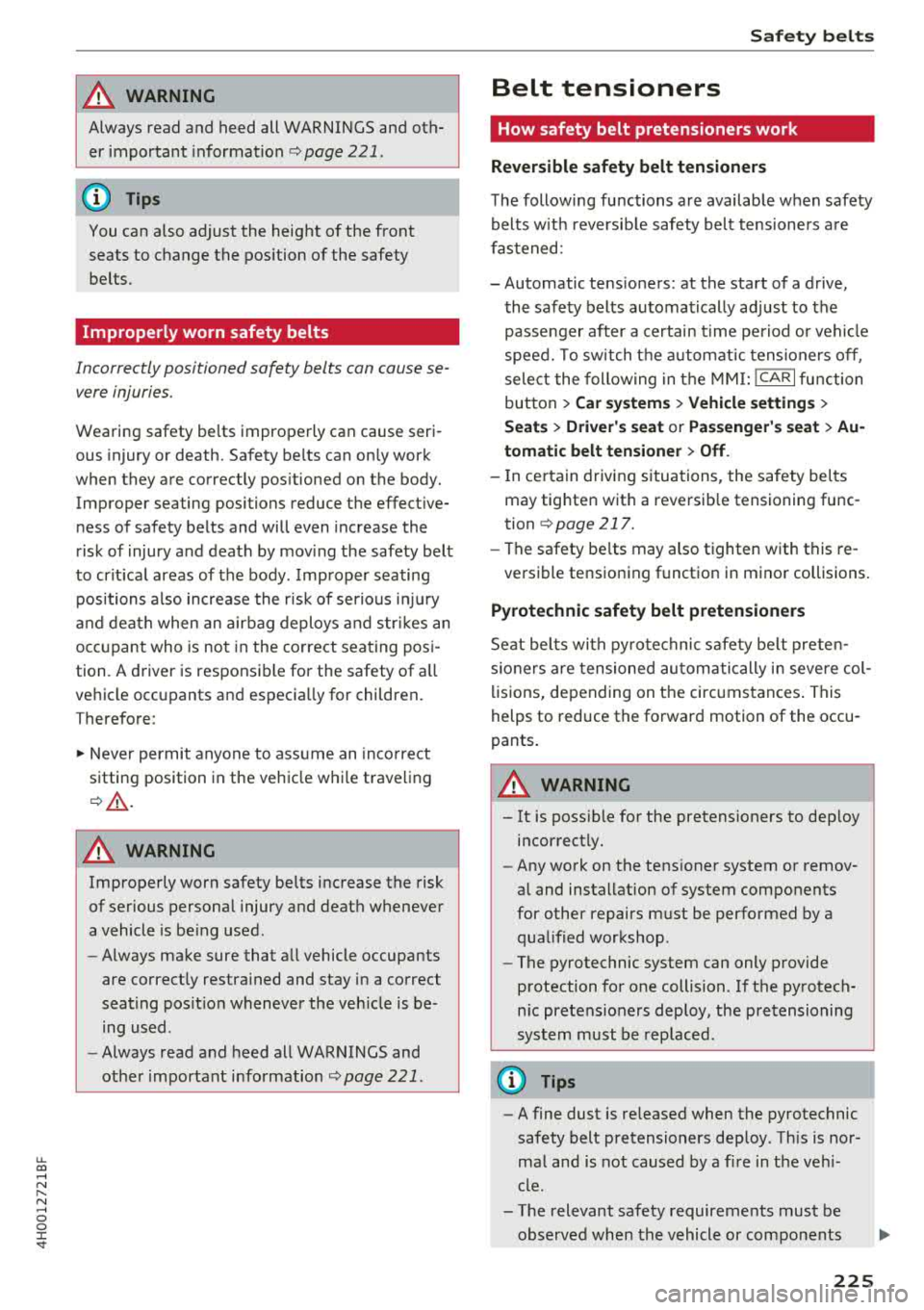
u. co .... N
" N .... 0 0 :c '
Always read and heed all WARNINGS and other important
i nformation¢ page 221.
(D Tips
You can a lso adjust the height of the front
seats to change the position of the safety
be lts.
Improperly worn safety belts
Incorrectly positioned safety belts can cause se
vere injuries.
Wearing safety be lts improperly can cause seri
ous injury or death. Safety belts can on ly work
when they are correctly pos itioned on the body.
Improper seating positions reduce the effect ive
ness of safety belts and will even increase the
risk of injury and death by mov ing the safety belt
to cr it ica l areas of the body. Improper seating
positions also increase the r isk of serious i njur y
a n d death when an airbag deploys a nd str ikes an
occupant who is not in the correct seating pos i
tion . A driver is responsible for the safety of a ll
ve hicle occupants and especia lly for children.
Therefore:
.. Never permit anyone to ass ume an incorrect
sitting position in the vehicle w hil e trave ling
¢A .
A WARNING
Improperly worn safety be lts increase the risk
of serious personal injury and death whenever
a vehicle is be ing used.
- Always ma ke sure that a ll vehicle occupants
are correctly restra ined and stay i n a correct
sea ting pos it ion whenever the ve hicle is be
ing used .
- Always read and heed all WARNINGS and
ot her important information
¢ page 221.
Safet y be lts
Belt tensioners
How safety belt pretensioners work
Rev ersible safety belt tension ers
T he following fu nctions a re available when safety
belts w it h reversib le safety belt tensione rs a re
faste ned:
- Automatic tens ioners: at the start of a drive,
the safety belts automatically ad just to the
passenger after a certain time period or veh icle
speed. To switch the a utomat ic tens ioners off,
select the following in t he M MI:
!CARI fu nction
button
> Car systems > Vehicle settings >
Seat s > Driver 's seat or Passenger 's seat > Au
tomatic belt tensioner
> Off .
- In ce rtain driving situations, the safety belts
may tighten wit h a reve rsib le tensioning func
tion
r=;, page 217.
- The safety be lts may also tighten with this re -
versible tensioning function in minor collisions.
Pyrotechnic safety belt pretensioners
Seat be lts wi th py ro technic s afety be lt preten
s io ners are tensioned au toma tically i n seve re col
li sions, depending on t he circumstances . This
helps to reduce the forward motion of the occu
pants .
A WARNING
= -
- It is poss ib le for the pretensioners to dep loy
incor rectly.
- Any work on the tens ioner system or remov
al and installation of system components
for other repairs m ust be performed by a
qualified workshop.
- The pyrotechnic system can only p rovide
protection fo r one collision. If the py rotech
n ic pretens ioners deploy, the pretensioning
system must be rep laced.
(D Tips
- A fine dust is re leased when the pyrotechnic
safety belt pretensioners dep loy. Th is is no r
ma l and is not caused by a f ire in t he ve hi
cle.
- The relevant safety requirements must be
observed when the vehicle or componen ts
225
Page 228 of 356
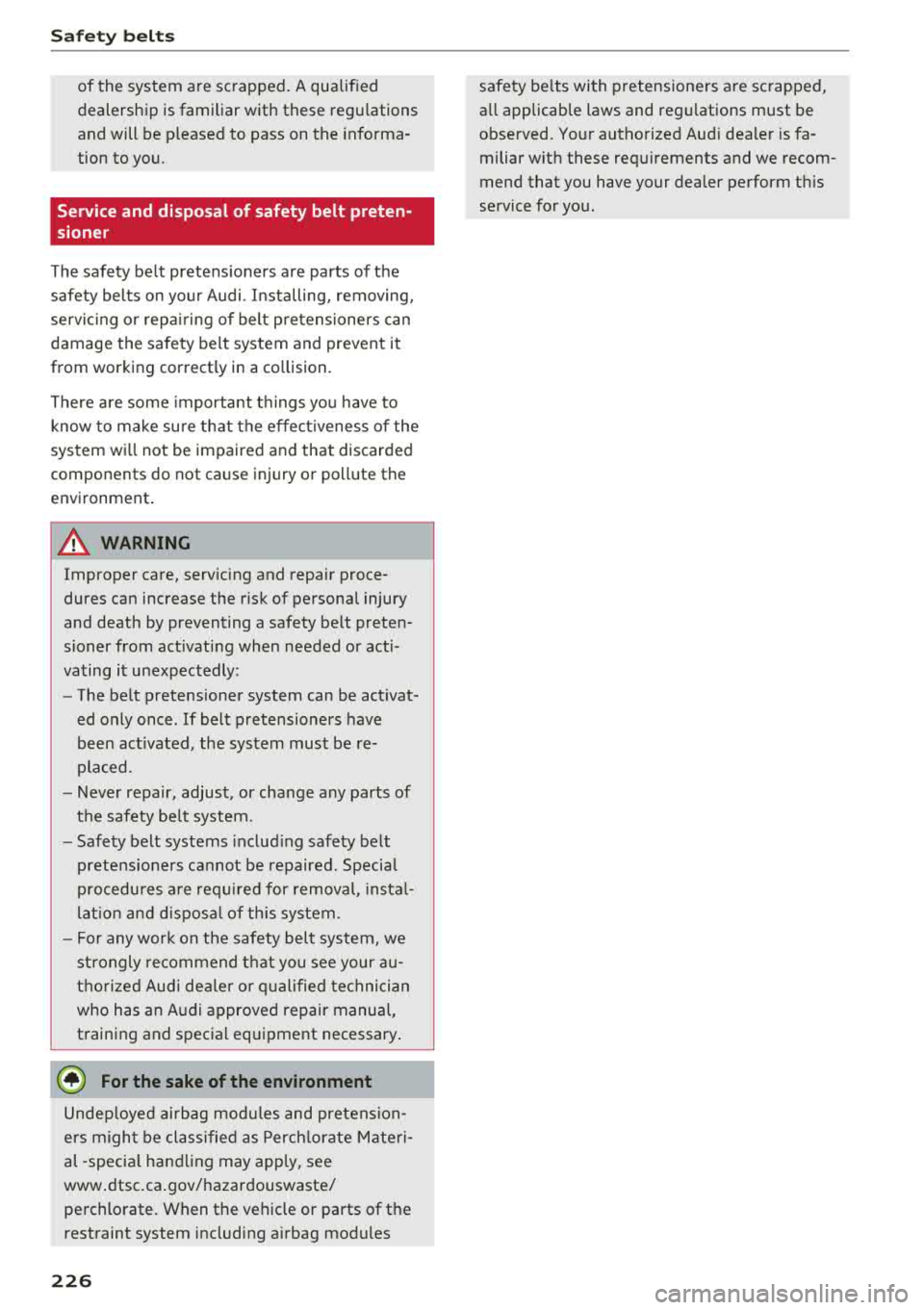
Safety belts
of the system are scrapped. A qualified
dealership is familiar with these regulations
and will be pleased to pass on the informa
tion to you.
Service and disposal of safety belt preten
sioner
The safety belt pretensioners are parts of the
safety belts on your Audi. Installing, removing,
servicing or repairing of belt pretensioners can
damage the safety belt system and prevent it
from working correctly in a collision.
There are some important things you have to
know to make sure that the effectiveness of the
system will not be impaired and that discarded
components do not cause injury or pollute the
environment.
A WARNING -
Improper care, servicing and repair proce
dures can increase the risk of personal injury
and death by preventing a safety belt preten
sioner from activating when needed or acti
vating it unexpectedly:
- The belt pretensioner system can be activat
ed only once . If belt pretensioners have
been activated, the system must be re
placed.
- Never repair, adjust, or change any parts of
the safety belt system.
- Safety belt systems including safety belt
pretensioners cannot be repaired. Special
procedures are required for removal, instal
lation and disposal of this system.
- For any work on the safety belt system, we
strongly recommend that you see your au
thorized Audi dealer or qualified technician
who has an Audi approved repair manual,
training and special equipment necessary.
@ For the sake of the environment
Undeployed airbag modules and pretension
ers might be classified as Perchlorate Materi
al -special handling may apply, see
www.dtsc.ca.gov/hazardouswaste/ perchlorate. When the vehicle or parts of the restraint system including airbag modules
226
safety belts with pretensioners are scrapped,
all applicable laws and regulations must be
observed. Your authorized Audi dealer is fa
miliar with these requirements and we recom
mend that you have your dealer perform this
service for you.
Page 229 of 356
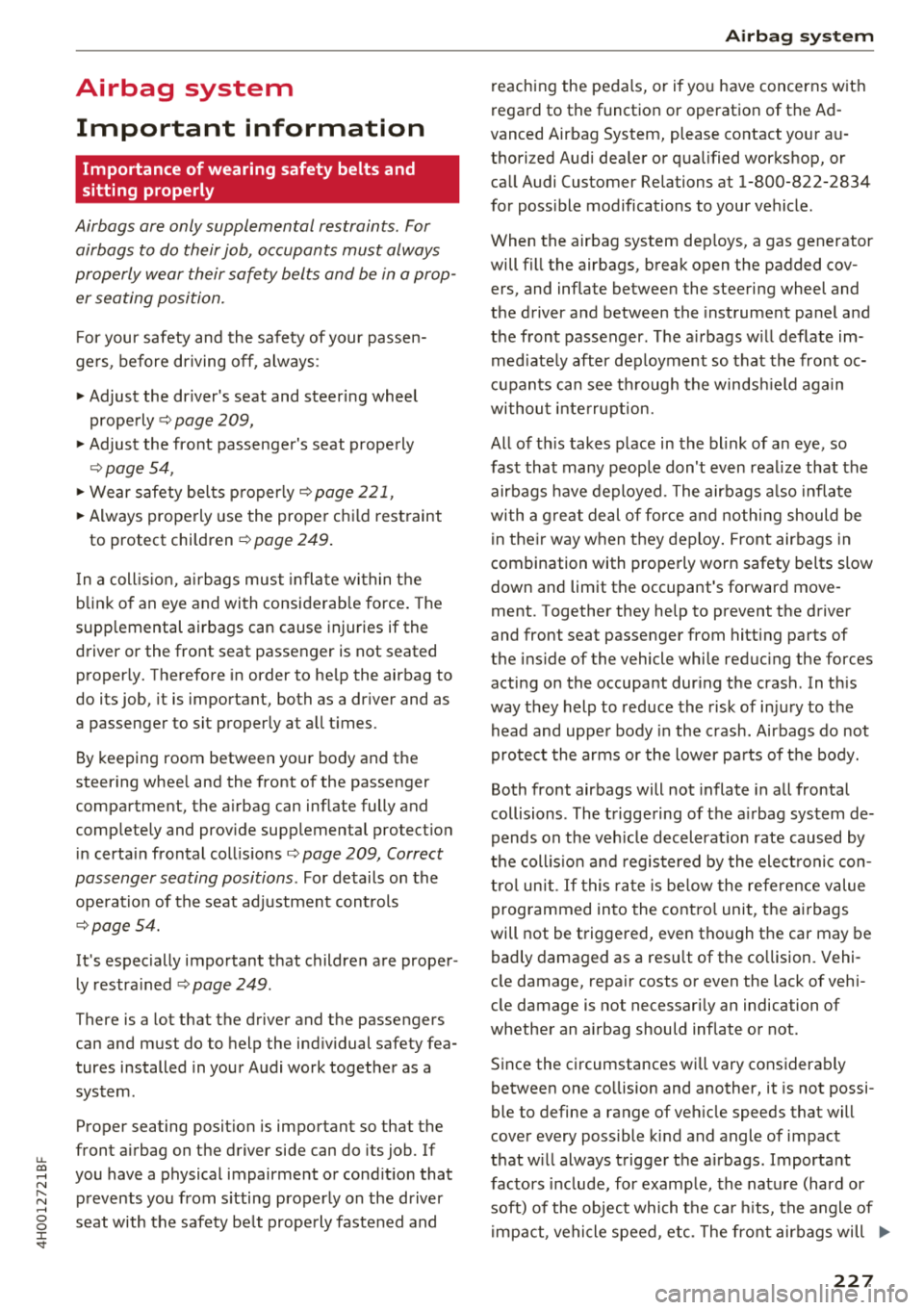
u. co .... N
" N .... 0 0 :c '
Importance of wearing safety belts and
sitting properly
Airbags are only suppl em ental restraints . For
airbags to do their job, occupants must always
properly wear their safety belts and be in a prop
er seating position .
For your safety and the safety of your passen
ge rs, before dr iving off, always:
.,. Adjust the dr iver's seat and steer ing wheel
prope rly~ page 209,
.,. Adjust the fro nt passenge r's seat prope rly
~page 54,
.,. We ar safety bel ts p roperly~ page 221,
.. Always properly use the proper c hild restraint
to protect chi ld ren
r=>page 249.
In a coll is io n, a irbags mus t infla te wi thin t he
b link of an eye and with consi derab le force . The
supp lemental airbags can cause injuries if the
d river or the front seat passenger is not seated
properly. Therefore in order to he lp the airbag to
do its job, it is important, both as a dr iver and as
a passenger to sit properly at a ll times.
By keeping room between yo ur body and t he
steer ing whee l and the front of the passenger
compa rtment, the airbag can inflate fully and
comp lete ly and prov ide supplemental protect io n
in certa in frontal coll is ions
r=> page 209, Correct
passenger seating positions.
Fo r de tails on the
operat ion of the seat ad justment cont rols
r=>page5 4.
It's especially important that children a re proper
ly restra ined
r=>page 249.
There is a lot that the driver and the passengers
can and must do to help the ind ividual safety fea
tures installed in your Audi work togethe r as a
sys tem.
Proper seating posit ion is important so that the
front airbag on the driver side can do its job. If
you have a physical impairment o r cond it ion that
p revents yo u from s itting properly on the driver
seat with the safety be lt prope rly fastened and
Airbag syste m
reaching the peda ls, o r if yo u have concerns w it h
r egard to the functio n or operatio n of the Ad
vanced Airbag System, please co ntact you r au
thorized Audi dea le r or q ua lified workshop, or
ca ll Audi Customer Re lations at 1-800-822-2834
for poss ible modifications to your vehicle .
When the a irbag system dep loys, a gas generator
will fill the airbags, break open the padded cov ers, and inflate betwee n the stee ring wheel and
the driver and between the inst rument panel and
the fron t passenger . The a irbags w il l deflate im
med iate ly after deployment so that the front oc
c u pants can see t hrough the winds hield aga in
wi thou t interru ption.
All of t his takes place in the bl ink of an eye, so
fast that many peop le don't even real ize that the
airbags have deployed. The airbags a lso infla te
wi th a g re at deal of for ce and n othing should be
i n the ir way when t hey dep loy . Front airbags in
combination with properly worn safety belts slow
down and limit the occupant's forward move
ment. Together they he lp to prevent t he driver
and front seat passenger from hitting pa rts of
the ins ide of the vehicle whi le red ucing the forces
acting on the occupa nt dur ing the crash. In th is
way they help to red uce the risk of in jury to the
head and uppe r body in the crash. Airbags do no t
pro te ct the arms or the lower pa rts of t he bo dy.
Both front airbags will not inflate in all frontal
collisions. The t rigge ring of t he a irbag system de
pends on the veh icle decelerat ion rate caused by
t h e coll is io n an d regis tered by the ele ct ronic con
t ro l unit. If this rate is be low the refe re nc e v alue
programmed in to the co ntro l unit, t he a irbags
will not be t riggered, even tho ugh t he car may be
badly damaged as a res ult of the co llision. Vehi
cle damage, repa ir costs or even the lack of vehi
cle damage is not necessari ly an indication of
whethe r an a irbag should inflate o r not.
S ince the circumstances will vary cons iderably
between one co llision and another, it is not possi
ble to define a range of ve hicle speeds that will
cove r every poss ible kind and angle of impact
t h at w ill always trigge r th e a irbags. Importa nt
factors include, for examp le, the nat ure (hard or
soft) of the object which t he ca r hits, t he angle of
im pact, vehicle speed, etc. The front airbags will
.,.
227
Page 230 of 356
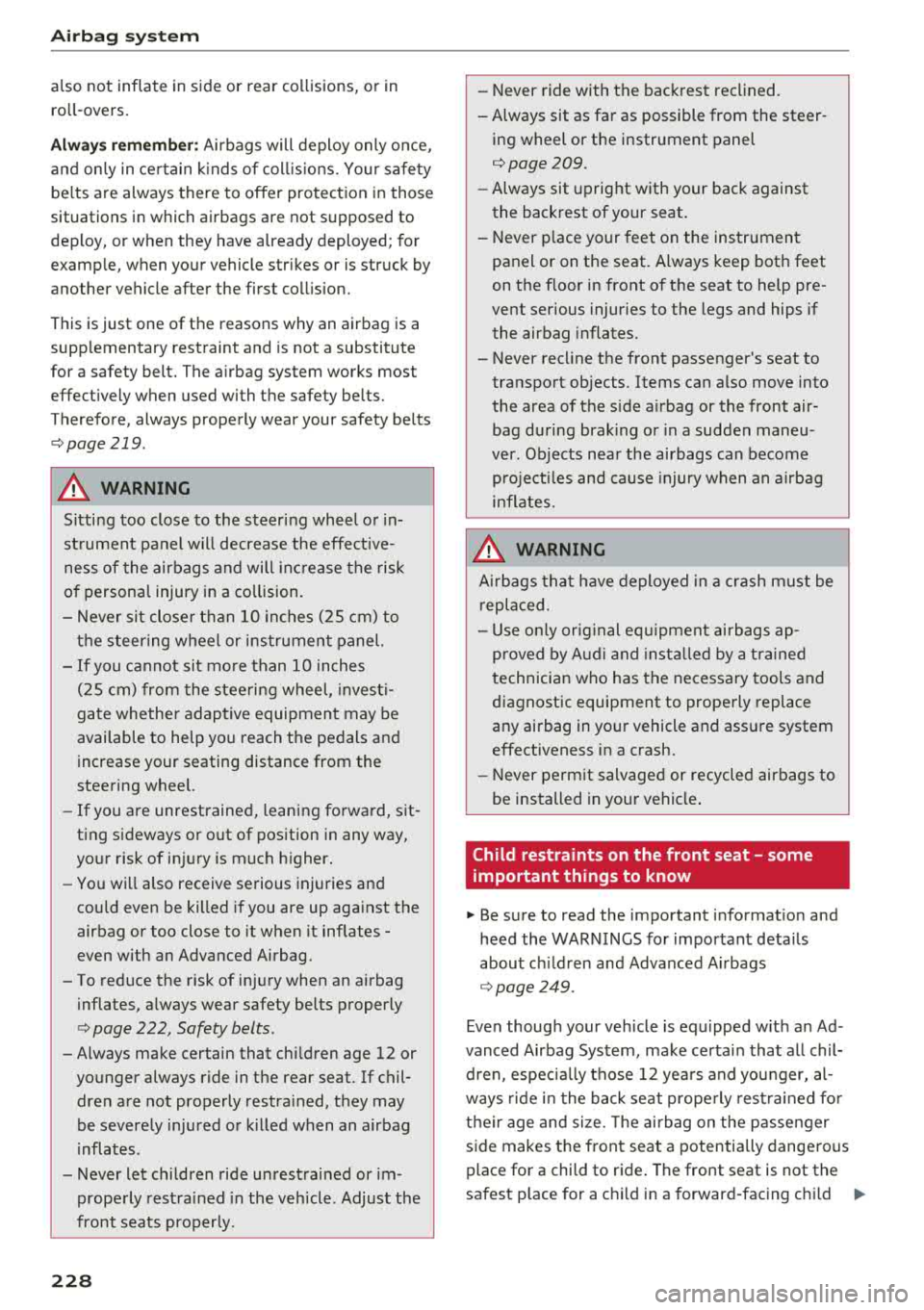
Airbag syste m
also not inflate in side or rear co llisions, or in
ro ll- overs.
Alwa ys rem ember : Airbags will deploy only once,
and on ly in ce rtain k inds of coll is ions. Yo ur safety
be lts are always there to offer protection in those
situations in which airbags are not supposed to
deploy, or when they have already deployed; for
examp le, when your vehicle str ikes or is struck by
another vehicle after the first collision.
This is just one of the reasons why an airbag is a
supplementary restraint and is not a substitute
for a safety belt. The a irbag system works most
effect ively when used with the safety belts.
Therefore, always properly wear your safety belts
r;:;, page 219 .
A WARNING
Sitting too close to the steering wheel o r in
st rument panel will decrease the effective
ness of the airbags and will inc rease the risk
of personal injury in a co llision.
- Never sit closer than 1 0 inches ( 25 cm) to
the steering wheel or instrument panel.
- If you cannot sit mo re than 10 inches
( 2 5 cm) from the steering wheel, invest i
gate whether adap tive equipment may be
available to help yo u reach the pedals and
increase your seating distance from the
steering wheel.
- If you are unrestrained, leaning forward, sit
ting sideways or out of position in any way,
your risk of in jury is much h igher.
- Yo u will also receive serious injuries and
could even be killed if you are up aga inst the
airbag or too close to it when it inflates
-
even with an Advanced Airbag.
- To reduce the risk of injury when an airbag inflates, a lways wear safety belts properly
c> page 222, Safety belts .
- Always make certain that chi ldren age 12 or
younger always ride in the rear seat. If chil dren are not properly restra ined, they may
be severe ly injured or k illed when an airbag
inflates.
- Never let children ride unrestrained or im prope rly restrained in the vehicle . Adjust the
front seats properly.
228
-
- Never ride with the back rest recl ined .
-Always sit as far as possible from the steer -
ing wheel or the instrument panel
c>page209.
- Always sit upright with your back against
the backrest of your seat.
- Never p lace your feet on the instrument
panel or on the seat. Always keep both feet
on the floor in front of the seat to help pre
vent serious injur ies to the legs and hips if
the airbag inflates.
- Never recl ine the front passenger's seat to
transport objects. Items can also move into
the area of the s ide a irbag or the front air
bag during brak ing or in a sudden maneu
ver. Objects nea r the airbags can become
pro jecti les and cause injury when an airbag
inflates.
A WARNING
A irbags tha t have deployed in a cr ash m ust be
replaced.
- Use on ly orig inal equipment airbags ap
proved by Audi and insta lled by
a trained
technician who has the necessary tools and
diagnostic equipment to prope rly replace
any airbag in yo ur vehicle and assure system
effectiveness in a crash.
- Never permit salvaged or recycled airbags to
be installed in your vehicle .
Child restraints on the front seat - some
important things to know
"' Be sure to read the important informat ion and
heed the WARNINGS fo r important deta ils
about ch ild ren and Advanced A irbags
r;:;, page 249 .
Even thoug h your veh icle is equ ipped w it h an Ad
vanced Airbag Sys tem, make certa in that a ll chil
dre n, espec ia lly those 12 yea rs and younger, al
ways ride i n the b ack seat prope rly res train ed fo r
t h eir age and size. The ai rbag on the passenger
s ide makes t he front seat a potentia lly dange rous
place for a child to ride . The front seat is not the
safest p lace for a c hild in a forward-fac ing c hild
.,.